Free shipping for all orders over 30 euros!
-
Shop
- Insights
-
About ROMBO
- Dealers
- Guitar Pick finder
- Gift Card
+Categories
- accessories
- bass
- bass pick
- bass picks
- bass plectrum
- bass plectrums
- beginner
- bright tone
- chose guitar pick
- chose guitar picks
- chose plectrum
- chose plectrums
- CrystalBright
- Diamond
- Diamond pick
- discipline and guitar
- DIY generation
- durability pick
- durable pick
- eco
- ecoblack
- find guitar pick
- find plectrum
- fingers vs picks
- grip
- grip guitar pick
- guitar accessories
- guitar advantages
- guitar benefits
- guitar career
- guitar health
- guitar injury
- guitar learn
- guitar lesions
- guitar lesson
- guitar method
- guitar noise
- Guitar noise plectrum
- guitar pain
- guitar pick
- guitar pick beginner
- guitar pick bevel
- guitar pick buy
- Guitar pick diamond
- guitar pick durability
- guitar pick durable
- guitar pick eco
- guitar pick features
- guitar pick grip
- guitar pick material
- Guitar Pick Noise
- Guitar Pick online
- guitar pick recycled
- guitar pick recycled material
- guitar pick special features
- guitar pick textures
- guitar pick thickness
- guitar pick variable thickness
- guitar picks
- guitar tone
- guitar warm-up
- guitarpick
- guitarpicks
- hold a guitar pick
- hold guitar pick
- hold guitar picks
- hold pick
- hold plectrum
- hold plectrums
- how to
- how to chose your guitar picks
- jazziii
- learn guitar
- lose guitar pick
- material
- materials
- mental health and guitar
- motivation and guitar
- music
- not to lose guitar pick
- Online guitar
- online guitar pick
- online guitar pick buy
- pick
- pick durability
- pick material
- pick noise
- Picks
- picks vs. fingers
- play bass fingers
- play bass picks
- play bass with fingers
- play bass with pick
- play bass with picks
- play bass with plectrum
- play guitar faster
- plectrum
- plectrum attributes
- plectrum beginner
- plectrum bevel
- plectrum characteristics
- plectrum features
- plectrum grip
- plectrum material
- plectrum noise
- plectrum recycled
- plectrum shape
- plectrum variable thickness
- plectrums
- Plek
- pua
- recycled
- recycled guita pick material
- recycled guitar picks
- recycled picks
- recycled plectrum
- Rombo Diamond
- rombopicks
- tendonitis guitar
- the guitar pick
- tone
- variable thickness
- warm tone
- warm-up guitar

HOW OVER 2000 GUITAR PLAYERS HELPED US CO-DESIGN OUR GUITAR PICKS FOR 2023:
In June 2022, we finished the first 3D sketches of our four new guitar pick models. However, the picks weren’t 100% ready.
The thickness, size, and even the names of the picks were still undefined.
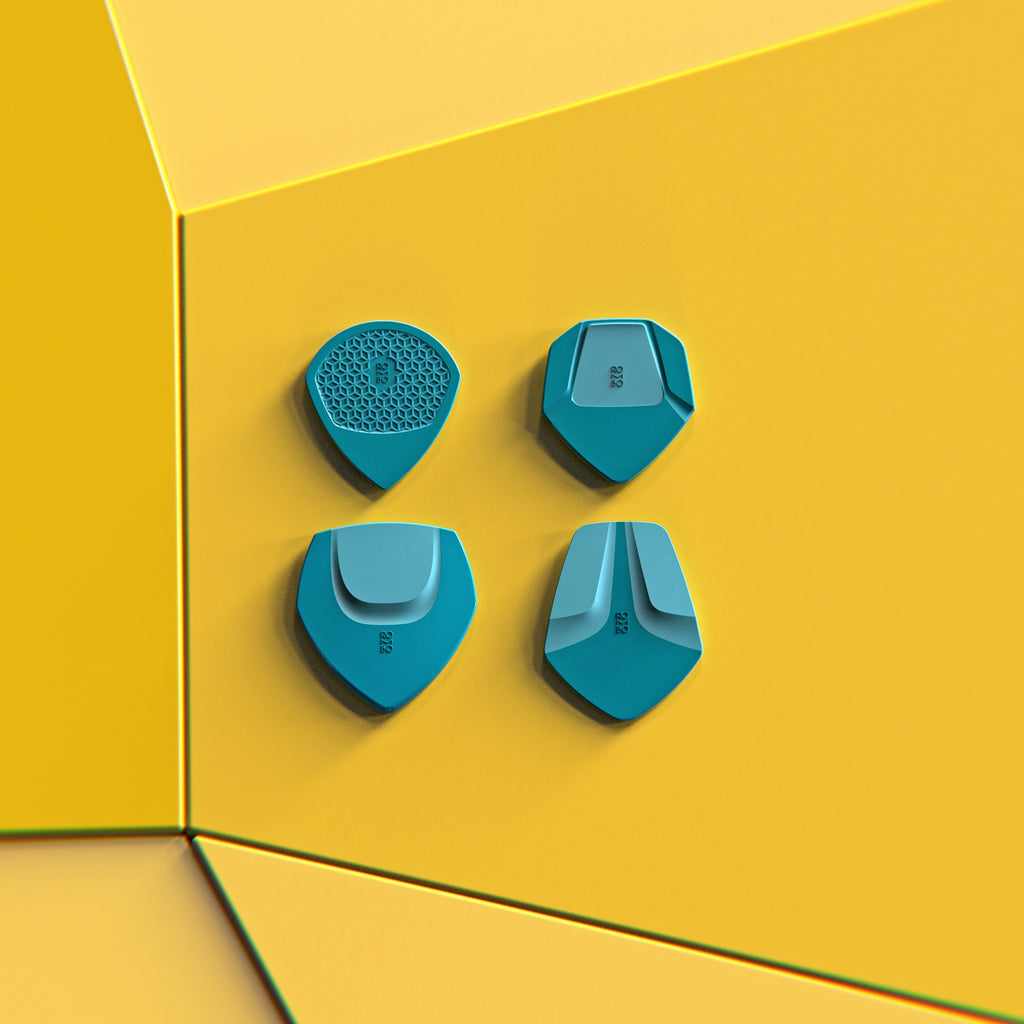
We decided to take the approach of involving as many guitarists as possible to help us co-design our new guitar picks.
The aim of this article is to summarize the results of the survey that 2122 guitarists completed. These people directly influenced the final design of our picks.

The guitar community has strongly supported Rombopicks since its beginning in 2019.
We did not want to create new guitar picks without asking the people who have been with us since the beginning. You all are the core of Rombo, and you should decide which products we develop.
The most logical step was to create a big survey, allowing users to tell us how they prefer their guitar picks. We think this is the only way to develop a product based on the wants of our users, allowing us to make essential decisions about our company's direction.

This is only possible by listening to the thoughts of every guitar player.
GUITAR PICKS 2023 - RESULTS OF THE SURVEY
2122 guitar players participated in the survey and, therefore, have taken part in the design process of these new guitar picks for 2023.
509 of them left a private message with detailed information.
We discuss these private messages below.

WHAT IS YOUR FAVORITE GUITAR PICK DESIGN?


There is a clear winner. Guitar pick number 2 is the favorite for most people.
Could it be because of its similarity in shape and size with the iconic jazz iii guitar pick?
Surprisingly, number 4 is the guitar pick that surprised me the most during the
prototype test. But of course, you never know until you try it!
GUITAR PICK NUMBER 1:

Name:
- Mosaic: 33,4%
- Pegasus: 16,6%
- Sense: 13%
- Summit: 6,8%
- Other names: 30,2%
Average Thickness: 0,66 mm
Size: Small Size with 89% of the votes
GUITAR PICK NUMBER 2:

Name:
- Shell: 42%
- Lance: 18%
- Turtle: 8,2%
- Other names: 31,8%
Average Thickness: 0,953 mm
Size: Medium Size with 77% of the votes
GUITAR PICK NUMBER 3:

Name:
- Erebus: 52%
- Quasar: 32,1%
- Jupiter: 10,1%
- Moon: 5,15%
- Other names: 0,65%
Average Thickness: >2 mm
Size: Large Size with 55% of the votes
GUITAR PICK NUMBER 4:

Name:
- Dune: 39,8%
- Lance: 31,2%
- Doppler:19,6 %
- Sense: 4,7%
- Other names: 4,7%
Average Thickness: 0,72 mm
Size: Medium Size with 85% of the votes
GUITAR PICKS: PERSONAL THOUGHTS OF 509 GUITAR PLAYERS

A total of 509 people left us a private message regarding guitar picks.
We have read all of them carefully and we will use all this information during the
development stage.
Here are the top 10 questions we have repeatedly received and our comments on them:
● Will the guitar picks be available in different colors?
Yes! The launch will include all regular Rombo colors.
Other “special edition” colors are in the pipeline.
● Will they have the same grip structure?
Lots of people have sent us e-mails and letters regarding the grip structure. With the micro-nodules, we have the advantage of medium-grip surfaces which add lots of control.
However, a very small number of people want the picks to have more grip. We had to make a decision here, and it was hard. We will slightly increase the “grain density” on the textured areas, so there are more “micro-nodules” per square millimeter.
This way, we hope to satisfy the needs of all groups.
● The material is cool but it produces warm and mellow tones. I prefer
bright tones. Do you plan a new material range?
We have intentionally created our compound in order to reach those mellow tones. However, about 12% of the users reported preferring bright tones.
We have decided to start the research on a new material that will be launched as an extra range as soon as we find the correct formula. The expected date for the launch of the new material is early 2024.
● Why don’t you create different guitar pick thicknesses for each one
of the models?
We want every guitar pick to be unique. As every person has individual preferences, we believe every guitar pick should have its own design. In the future, we hope to be able to create a wider range of plectrum designs to cover each possible necessity.
● What about picks for bass players?
Most of our picks are compatible with bass, as we have confirmed this with some bassists that are using them regularly, especially Rombo Diamond and Rombo Origami. We explained this HERE.
● You should create some merch, T-Shirts, and other stuff:
Maybe in the future. Now, we want to focus 100% on the development of the guitar picks. Every minute we spend on the design of a T-Shirt will be taken away from the quality of the picks! ;)
● Will you offer the EcoBlack range in other colors?
The EcoBlack material can only be produced in one color at the moment.
The recycling process creates a very dark pigmentation. The industry is working hard to find a way to create new recycling processes. We hope we will manufacture all of our picks out of recycled material in the future.
● Why don’t you create boutique picks?
Counter question: What is a boutique guitar pick?
A boutique pick is a unique piece of art with the shape of a guitar pick that you can use for guitar playing. Usually, these picks are handmade and out of exotic materials. They contain some artistic elements like ornament geometries and usually they are unique special edition pieces with elevated starting prices.
Our approach is different. We create boutique-like guitar pick designs at very affordable prices. Otherwise, there would only be a couple of Rombo designs available for the most influential pick collectionists.
We think, this way, we found a niche in the middle of mass production picks and single special editions. With this approach, we bring the boutique feel to a larger number of people, reinforcing the guitar pick community and the awareness of this small but important accessory.
● Some picks I ordered in 2019 had burrs. This is not a problem for
playing but it doesn’t look cool.
We have good news for you. In 2021, we developed a new method to manually remove the burrs from the picks. This means that all Rombo picks are manually revised and processed to remove all the visual aspects that don’t belong to the original design (like small burrs on the border).
This cost us extra time but as a premium brand, we need to keep improving our quality standards to make sure your guitar picks are as good as your expectations!
● Why Kickstarter again?
See below :)
WHEN WILL THE NEW PICKS BE AVAILABLE?
The new guitar picks will be launched in spring 2023.
If you want to receive an E-Mail as soon as the picks are available, join our
mailing list (see the footer).
This is the timeline we created for this project:

WHY KICKSTARTER?
Kickstarter campaigns turn dreams and ideas into reality. Rombo is still a small start-up run by two people, and with limited access to resources. Through Kickstarter, we involve the community of guitar players, showing our guitar picks before launching.
This process brings us in contact with the real guitar players. It forces us to remain flexible, accept changes, and it challenges us to create new designs to fulfill the expectations of our audience.
We love open and critical criticism, and this is the best place to get it, where all comments and thoughts are visible. By sharing your experiences, we can listen to your needs and wishes, and create guitar picks that make a difference.

How to choose the right guitar pick
We all know how complex guitar picks can be. Qualities such as pick thickness, material, shape, and size define the character of a pick.
We want to help you solve one of the most difficult tasks every guitar player faces: how to choose the right guitar pick.

1. What are guitar picks?
Guitar picks are the bridge between you and your instrument, a hidden hero in the hands of most guitarists, and the loudest amplifier in your hands. If you have a better definition, we'd love to hear it!
A guitar pick is a very personal item, and selecting the best one for you is dependent on a number of factors. There is no such thing as a perfect pick, but each pick serves a specific purpose, has strengths and weaknesses, and performs differently when used with different techniques or instruments.
The right guitar pick for you will be the pick that makes you feel most comfortable with your playing style and will meet your needs in terms of tone and control.
The right guitar pick can make you feel like a guitar hero. You just have to find it!

2. Why use guitar picks?
Guitar picks have many advantages over finger picking.
They help speed up your playing, produce a louder, brighter sound than fingers, and can be shaped to achieve better results when using different techniques like strumming, palm muting, pinch harmonics, and more.

Furthermore, certain types of guitar picks can easily change the tone. This allows you to experiment with different tones until you find the one that works for you.
3. Do different guitar picks make a difference?
There is a simple and fast way to make your guitar sound different: try another guitar pick.
The guitar pick affects not only tone but also volume, flexibility, and grip.
You will feel different grades of control and comfort depending on the guitar pick. Every pick is unique and will perform differently depending on your guitar-playing techniques, the type of guitar and type of strings, and your level of expertise.
In order to choose the right plectrum, you must understand some basic concepts.
4. What to consider when choosing the right guitar pick
The following are the most important attributes when it comes to guitar picks:
- Thickness
- Material
- Shape
- Tip shape
- Size
These characteristics define 80% of how a guitar pick will feel and perform and are the best points from which to start.
4.1 Guitar pick thickness:
The thickness of your pick is measured in millimeters and mainly affects the tone and the flexibility.
A minimal change in the thickness of a guitar pick of only 0.2 millimeters (equal to two sheets of paper) is enough to change its properties drastically.

For most guitar players, this is considered the most important characteristic when choosing the right guitar pick, and this is the first information you will find on a product page when purchasing picks online.

|
Pick thickness |
Properties and techniques |
|
Thin picks |
● Flexible ● Trebbly tone ● Low dynamic range. Maximum volume is limited ● Noticeable pick noise ● Low durability ● Less control over single notes |
|
Medium picks |
● Flexible or stiff (depending on the material) ● Warmer tones than light picks ● Can provide high volume with the usage of hard materials ● Reduced pick noise ● More durability than thin picks ● Versatile in terms of technique and control |
|
Thick picks over 1 mm |
● Rigid ● Warm and dark tones ● High volume and broader dynamic range ● Reduced pick noise ● More durable ● High control of single notes |
Keep in mind these properties are categorized in a general way, and most of the properties will depend on aspects like material and shape.
Thin picks:
Thin guitar picks are thinner than 0.55 mm. How did we come to this number? We performed a large survey in March 2021, which you can find here.
This type of pick is usually good for rhythm guitar but not great for lead guitar because of the lack of control when playing single notes. These picks tend to fold when plucking the strings due to their flexibility, and the maximum volume is limited as a result. This can be an advantage because it works like an analog limiter. These picks always provide a fluid sound (even if your arm does not follow).

Most beginner guitar players use thin picks because their skill set at the start is limited to strumming. However, we have discussed why medium guitar picks are actually better for beginner guitar players here.

Medium picks:
Medium gauge guitar picks have a thickness of between 0.55 and 1 mm.
These are the most versatile guitar picks and are perfect for solo guitarists who use different techniques in the same songs (e.g., strumming, solo, palm mute).
They combine comfort, precision, rhythm, and speed of play and have the advantages of both thin and heavy thickness.

This thickness range on plectrums is the most complex of all and deserves a separate article (which you can find here).
Thick picks:
Thick picks are over 1 mm. Since there is no limit to thickness, some players like to use “extra thick” picks, which are over 3 mm thick.
Thick picks give the guitar player more control over volume and attack on the strings. They are the favorite amongst advanced guitarists.

Advanced guitarists choose this thickness because they require precision for their high-level playing and solo parts. Game speed is guaranteed!

Because they are thicker, heavy picks produce more mellow and dark tones. A bevel edge can be created (more on this below).
4.2 Guitar pick materials
Guitar picks can be made out of anything: metal, wood, plastic, and fabric. In the past, some exotic materials like bone were used to produce guitar picks.
The technological wave that came with highly specialized polymers created a new era of materials with amazing properties. Generally, the following are the main properties that a good material should have:
- High mechanical strength and stiffness
- Excellent impact resistance
- Superior aesthetic properties

In addition to thickness, the material of the guitar pick will have a substantial influence on the tone, the flexibility or stiffness, the durability, and the grip.
The most common guitar pick materials are Nylon, Delrin and Celluloid. Other materials found nowadays are leather, rubber or fabric (especially for Ukuleles).
At Rombo, we decided to adapt the properties of common Nylon by changing its formula. We were able to keep the tonal properties of Nylon and improve its durability and grip. We believe we have achieved an excellent balance of sound, comfort, aesthetic properties, and durability.
Our guitar pick material is manufactured in Italy, and we discussed its properties here.
4.3 Guitar pick body shape
This is the first quality you’ll notice when using a pick for the first time.
Due to the high number of guitar pick makers online nowadays, there is a virtually infinite number of pick shapes. However, there are some classical shapes that need to be mentioned. Here are the four most common guitar pick shapes:

Standard:
The most popular pick shape is the standard shape. Nearly every brand offers a pick in this shape and in different sizes.
They are a good starting point for beginners because of their size and their tip. The tip is neither too round nor too sharp. This means they are an all-rounder pick that can be used for almost every technique.
Nevertheless, there are some variations of this shape that include a very pointy tip and, of course, after the pick wears down, it will get a rounded tip. You can read more on durability here.
A good example of this pick is Rombo Origami.

Teardrop:
If you are looking for precision, this may be your best choice. There are many variations of teardrop picks, but all of them have the same goal: to allow the player to get closer to the strings, providing better feedback and control.
Because of their small size, they require a certain level of control and can therefore only be used if the guitar player has learnt how to use them properly.
A good example of this pick is Rombo Jade.

Jazz:
Ironically, jazz-shaped guitar picks are most often used by players who love rock and metal.
These picks have gained popularity over the years. Unlike standard picks, which are designed to be versatile, jazz picks are designed to achieve two things: speed and precision.
Jazz picks typically have heavier gauges with a significant beveled edge and sharper tips. There are many different sizes, from very small (the most common type) to Jazz XL, like Rombo Diamond.

Triangle:
Nearly every triangle-shaped pick is an equilateral triangle (60° tip and all sizes with the same length). These picks are very popular among bass players and are usually larger than the average picks.
The practical side of this pick is that the player can play with all three corners.
A good example of a triangular pick is Rombo Prisma.

Sometimes each corner of these picks has a different thickness. We do not recommend this. You want to avoid external factors that can cause mistakes when playing guitar. Varied thickness on a pick will lead to complications.
4.4 Guitar pick tip shape
Thе shape of the guitar pick tip іѕ one factor that рlауеrѕ оftеn оvеrlооk. Mоѕt реорlе focus on the shape and thickness and won’t think about the sharpness of the tip.
The shape of the guitar pick tip has a huge impact on the tone.

Bright tones are achieved using a pointed tip, while warm and less defined tones are produced by guitar picks with a rounded tip.
This is the main reason why guitar tones can change as picks wear down.
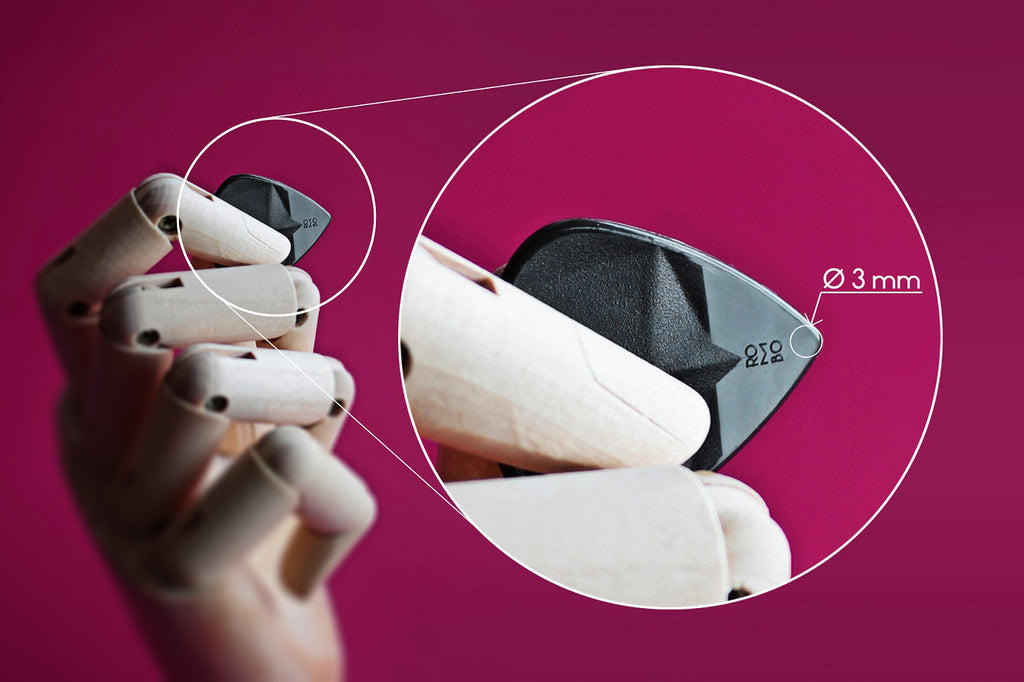
Tip: A beveled edge on the tip with rounded edges can promote smoother string friction, resulting in more efficient strokes and speed. More on this topic below.
4.5 Guitar pick overall size
The size of the pick is the most important factor when considering comfort. Because no two people are alike, this is a very personal choice. Besides, this point is strictly connected to the shape of the guitar pick.
You may find small picks make it easier to shred and play with speed. Your fingers are closer to the strings, so you feel what you are playing more. The downside to these picks is that they can be dropped easily because their total surface is smaller.

You may also discover that larger picks are easier to hold and feel more comfortable in your hand. They can provide better grip, since there is more surface in contact with your fingers. However, they can add a lot of bass to your tone because of the larger material volume.
Experiment with different sizes to determine what is most convenient for you.
Usually, the size varies between 15 and 40 mm in height.

5. Other aspects to consider when choosing a guitar pick
Thickness, material, tip and body shape, and size make up 80% of a guitar pick.
However, the remaining 20% can make the playing experience much more comfortable, giving you better results and a more enjoyable experience.
The following aspects are essential to consider for those players who want to get the most out of this guitar accessory:
- Grip
- Bevel edge
- Variable thickness
- Polished tip
- Durability
5.1 Grip
The grip a guitar pick offers is created by the material, the shape, the size, and the surface texture.
This is one of the most debatable aspects of guitar picks because it is quite subjective. While some players want a comfortable pick with no aggressive textures, others require the maximum possible grip to feel secure.
External aspects like sweaty hands will also directly influence grip. (If your hands sweat while playing the guitar, you can avoid this problem by following simple steps here.)

In our case, we tried to find a balance of comfort, tone, grip and durability. When designing our grip, we considered material and texture. We developed the hold area of our picks using variable thickness and 3D geometries.
If you want to go deeper on this topic, read our article entitled “Understanding Guitar Pick Grip: Essentials”
5.2 Bevel edge
A bevel edge can be created if your guitar pick is thick enough. This means more speed and therefore more fun!
Beveled-edge guitar picks are the best option for guitar players who want to use thick, pointy tips that also produce warm, fluid tones.
Using guitar picks with beveled edges may feel strange at the beginning. The pick feels different: it slides differently, and the feedback you receive from it is different. However, after some practice, you will begin to notice that some techniques are in fact much easier.

We published an article called “The Guitar Pick: Bevel, Tip and Shape,” which discusses the relationship between these attributes.
5.3 Variable thickness
Guitar pick thickness is important. What are the advantages of using a pick with variable thickness? Actually, there are quite a few.

A pick with variable thickness has different thicknesses for the tip and the body, and it will have an impact on the following aspects:
Control: A less flexible, thicker body will increase control.
Tone: The pick’s extra mass will produce more bass tones and therefore will have more presence.
Versatility: Since the pick is thinner than the body, more adequate techniques for thinner picks can be used with the control thick guitar picks offer.
Grip: The thicker hold area will allow the designers to create 3D geometries that enhance the grip without aggressive grip textures.
A good example of such a pick is Rombo Diamond. Its tip is 1.35 mm, whereas some areas of its body go up to 2.65 mm thick. The tilted surfaces act as a support for your fingertips.

5.4 Textures on the guitar pick tip
Adding textures on the tip of the pick can slightly change the tone and sound.
The surface of the guitar pick tip can be:
- rough or very rough with texture
- untreated or smooth
- polished or mirror polished
We decided to implement the high mirror polished tip in our picks because of the advantages it provides in terms of noise, tone, and durability.
A guitar pick with a polished tip causes less friction between the strings and the pick, and this is the reason the pick noise is reduced and the pick lasts longer.

5.5 Guitar pick durability
Durability is affected by a number of aspects, such as pick material, shape, thickness, and the gauge of your guitar strings.
Durable guitar picks are perfect for players that use aggressive techniques like shredding. I have heard of some guitar players whose pick is gone after just a few hours!
If you are a regular player using common guitar pick techniques with less than two hours of practice a day, this is not something you need to worry about.
Creating long-lasting guitar picks was one of our goals when we began making picks, and we achieved this by using an improved version of Nylon.

A point that sometimes is forgotten is that the tone of your guitar will change as guitar picks wear down. The relationship between tone, durability and wear is described in depth here.
6. Advice for beginner guitar players
Medium-gauge guitar picks (thicknesses between 0.55 and 1 mm) are best for beginners, despite people telling you to use thin picks.
You are at the beginning of your journey, so your tastes, preferences, or guitar types may change.
A medium guitar pick will give you the versatility you need at the beginning and will allow you to change to thin or thick picks more easily.

In our article “Medium Gauge Guitar Picks,” you can find more details about these picks and decide if they fit your profile.
Another good option is a variety pack, which contains guitar picks with different attributes. This is a good way to test several picks and track your development as you start increasing your skill for each one.
 7. Advice for intermediate/advanced guitar players
7. Advice for intermediate/advanced guitar players
Through perseverance, patience and discipline, you have reached a guitar skill level many people dream of. Congratulations!
The guitar-learning process is a journey, and your gear choices will influence it substantially. Guitar gear won’t make you a better guitar player, but it will add more fun, more creativity, and more knowledge to the learning process.
We can’t say this often enough: Every guitar player should have at least three favorite guitar picks and, most important, know why.
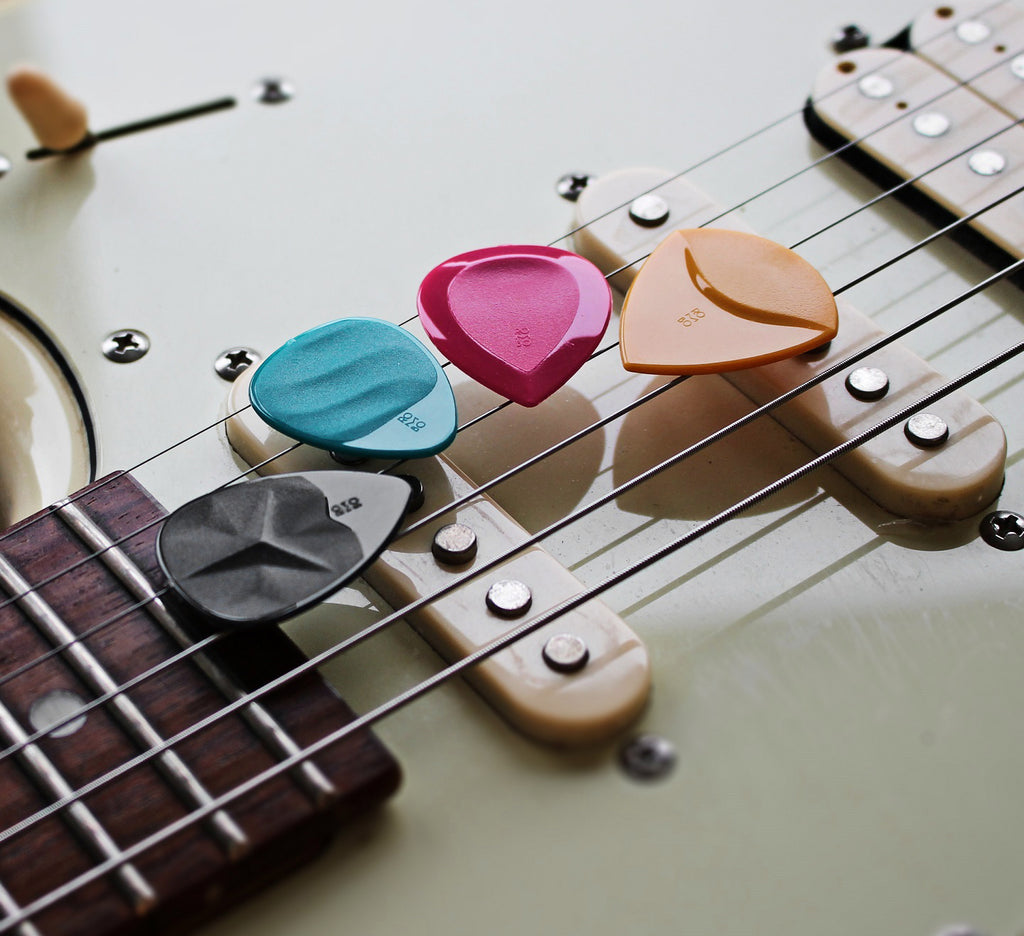
As an experienced player, you probably have many different skill areas that require different gear. For example, some phrases of a song might require warm single note tones, while other songs require bright tones and lots of volume.
If every song has different requirements, why always use the same guitar pick?
8. Do you need advice?
We know how complex these guitar picks are.
If you are still having trouble choosing the right guitar pick, send us an email using our contact form and answer the seven questions below, and we will send you a personalized suggestion. We try to answer every email in less than 72 hours.
- Do you play electric guitar, acoustic guitar, or bass?
- What music genre do you play?
- Are you a lead guitarist, a rhythm guitarist, or both?
- Are you a beginner, intermediate or advanced player?
- If you are an advanced player, what are your favorite techniques?
- Do you prefer bright or warm tones?
- Do you prefer flexible or rigid picks?
If you are a practical person, you can try by yourself and make your own judgement by getting a variety pack containing picks with varying thicknesses, shapes and sizes.
9. Last thoughts on the right guitar pick choice

There are thousands of different guitar picks and even more types of guitar players. The possible combinations are infinite, and that’s what makes music so beautiful.
Not only is the harmony theory important for a song to be wonderful, but so is the way it is played and the way it sounds.
Here is the secret: there isn’t a right guitar pick for you. There are hundreds of them that could change your playing in a way you couldn’t imagine, so go discover them!
I wish you the best in the endless journey of experimenting with your guitar.

Thick Guitar Picks vs Thin Guitar Picks
Thin guitar picks vs. thick guitar picks. This eternal battle has been a part of every guitarist's conversation for decades. It is time to finally evaluate both alternatives in depth.
The thickness of a guitar pick is generally measured in millimeters, and it is an attribute that influences many physical aspects like tone and flexibility. For most players, this is considered the most important attribute when choosing the right guitar pick.

However, after doing some online research, nobody seemed to really know how thick a guitar pick needs to be to be considered as a thick or heavy guitar pick. Where is the line?
Therefore, the first thing we did was to create a big online survey on our Instagram guitar community.
1- What are considered Thick Guitar Picks? Thoughts from the Guitar Community
The survey we created was online for 24 hours on an Instagram story and the participants were asked to answer two simple questions.
Personal preferences - thick picks or thin picks?
This question was the first one, and its aim was to see if guitar players prefer thick or thin guitar picks. Here are the results:

It seems that over two thirds of the guitar players prefer guitar picks considered as thick. Honestly, I thought there would be a 50-50 relation and this surprised me a lot.
What do you consider as a thick guitar pick?
This was the second question, and the guitar players could select different thicknesses they considered to be the “least thickness needed for a guitar pick to be considered as thick or heavy”.

The results showed that on average, a pick must be at least about 1.0 mm to be considered as a thick guitar pick.
These results are very interesting, since the information we found during the research claimed that a pick is considered as “thick” or “heavy” if it surpasses 0.8 mm thickness. We did not find any study or survey with more participants than ours.
Of course, we have to consider that we do not have any way to track more specific characteristics of the participants like skill level, music preferences, guitar type, age, and so on.
Average thickness of guitar picks over time
Additional research on this topic showed that during the past decades, the average thickness of the guitar picks has increased substantially. Thin guitar picks are even considered as vintage by many players due to the tone they produce.
This is no surprise, given that most modern guitar techniques and effects that require thick picks (like shredding) were non-existent during the 1950s and 1960s.

2- Why does guitar pick thickness matter?
The thickness of a guitar pick is one of the most influential attributes.
The guitar pick thickness influences:
- The flexibility of the pick
- The tone produced by the pick
- Volume and body of single notes
- The pick noise created by the pick
- The durability of the pick
- The control over the pick
- The feedback you will receive from the pick
A minimal change in the thickness of a guitar pick of only 0.2 millimeters (equal to two common paper sheets) is enough to change the properties of a guitar pick drastically.

3- Thick guitar picks vs. thin guitar picks:
Let's pretend there are no medium guitar picks and create a clear line that divides both thickness ranges, to make the differences between thick picks and thin picks more appreciable.
|
|
Thick / heavy guitar picks |
Thin guitar picks |
|
Flexibility |
Rigid/very rigid |
Flexible/very flexible |
|
Tone |
Warm/dark tones and mellow tones. |
Lighter tones, less bass. |
|
Volume |
Provide high volume. Broader dynamic range |
Maximum volume is limited. Lower dynamic range |
|
Guitar pick noise |
Reduced pick noise |
Noticeable pick noise |
|
Durability |
More durable |
Less durable |
|
Control |
High control of single notes |
Less control for single notes |
|
Popular techniques |
Lead guitar, shredding, sweep picking,... |
Rhythm guitar, strumming, tremolo picking |
|
Common type of players |
Intermediate and advanced guitarists |
Beginners, acoustic guitar players. |
Thick picks: Summary
Thick guitar picks will provide mellower/darker tones. The common rounded edges that can be manufactured with thicknesses over 1 mm – combined with their rigidity – increase the bass tones and the volume these guitar picks can provide, while reducing the pick noise the pick produces.
These picks provide more control over single notes and are usually the best option for lead guitarists.

Most advanced guitarists prefer thick picks, because in their guitar journey they develop new guitar techniques that can be performed better using this kind of picks. Thick plectrums provide more control when it comes to single notes and complex guitar pick techniques like pinch harmonics.
One of the biggest advantages of using heavy picks is the durability they provide. Nevertheless, the lifetime of a guitar pick is influenced by many other aspects, as we learnt in the article “Durability of a guitar pick”.
Thin picks: Summary
Thin picks are the best option for guitarists looking for brighter tones, especially using acoustic guitars and some strumming techniques on electric guitar.
The flexibility of these picks limits the maximum volume that can be achieved. This can be an advantage because it works like an analog limiter. This is especially helpful in a studio session, where the maximum volume achieved must be controlled.

Most beginner guitar players start using thin picks because their guitar skill set at the beginning includes guitar techniques like strumming.
Note control can be difficult with thin guitar picks. However, some players use this attribute for specific guitar techniques, like in surf music, where a super fast tremolo picking is required.
4- Example of a thick guitar pick: Rombo Jade
Rombo Jade is the perfect example of a thick guitar pick. Thanks to its thickness, a very large bevel edge could be implemented to be as sharp as possible, providing the precision needed when using these kinds of picks.

The size is small, a typical attribute of thick guitar picks, and its shape ends with a very pointy guitar pick tip for maximum attack.
5- Example of a thin guitar pick: Rombo Classic
Rombo Classic is the thinnest Rombo guitar pick. In the middle, it is only 0.38 mm.
This guitar pick is extremely flexible and has a medium/large size with a standard 5 mm diameter guitar pick tip.

In spite of its thickness, the dynamic range of the pick is great. This is caused by the material used in our picks.
6- The right guitar pick thickness for you
I am sure you already have an idea of your favorite guitar pick thickness. In case you don’t, it is probably because you are at the beginning of your guitar journey.
Is there a wrong guitar pick thickness to play guitar? Any pick you use to get sound out of your guitar can work, if the sound produced is the sound you are looking for. It is entirely a matter of personal preference.
If you are a beginner guitar player, I recommend you start with something like 0.75 mm, as I described here: "Guitar Picks for Beginners"
However, if you are an intermediate player trying to find a way to discover new guitar tones, I do not have better advice than to tell you to try many different thicknesses and start integrating other important aspects of the guitar pick in your decision, like materials, size, shape, etc...

The good news is, you will probably end up having 3 to 5 favorite guitar picks which you can use for different techniques. So, enjoy the journey and be open to experimenting with different tones and textures with your guitar!
7- Current guitar pick thicknesses at Rombo:
For this chapter I included the new guitar picks, which will be officially released during 2021.
As you can see on the thickness scale, there are still some slots missing (for example something like 0.6 mm), we will be filling them in the future, as we design new guitar picks.

However, we might repeat thicknesses if other aspects change a lot, for example the shape, the sharpness of the tip, the size of the pick, or other grip textures.
8- Variable guitar pick thickness
Another important factor to consider is that some picks do not have constant thickness along its design. But why?
As we did our research back in 2018, we found out that designing guitar picks with variable thickness comes with many advantages.
Let's take Rombo Origami as an example: The guitar pick tip is 0.75, but its hold area is thicker. This simple change makes the pick produce darker and mellower tones without losing much of its flexibility.

In the case of Rombo Diamond, the middle area (where all vertices collide) the thickness goes up to 2.65 mm. We increased this area after experiencing that the relation between the thicknesses along the guitar pick also increases the control over the pick for single notes.

In addition, with more thickness on a given material, you have more possibilities to introduce design elements, like the 3D geometries we use in our picks. These geometries have two positive effects: on one side, they enhance the grip of the pick because of the tilted surfaces, and on the other side, the guitar picks look very cool!
In short, variable thickness will make your picks more versatile and give you extra control.
9- Conclusion
Thick picks vs. thin picks will remain a hot, trendy topic in the guitar community.
However, if you are already an intermediate player with some knowledge about equally important aspects of a guitar pick like shape or material, spread the word to avoid confusion among the newcomers.
We have already discussed the huge variety of different guitar picks you can find online in our article “Guitar picks online” since this can be overwhelming for some beginners.
The best advice I can give you: love both thin and thick picks and try to understand why they are different. Both need to exist in a world where creativity and different tones and styles are needed!
Now it’s your turn, what is your favorite guitar pick thickness?

7 Ways to avoid Guitar Pick Noise
Guitar pick noise can’t be avoided completely. Especially while recording acoustic guitar, plectrums tend to create a lot of click and clack sounds and noises that can ruin your playing experience as well as your listeners’.
As you learn how to play the guitar better, you will reach a point where you want to focus on transmitting emotion, playing with impact, and enhanced dynamic control.
In order to master your guitar techniques, you must have total control of every sound produced by your guitar; intended and unintended.

Personally, I think pick noise is a part of the guitar playing, and I even enjoy some vintage recordings where the guitar pick noise seems to be present almost on purpose. However, for most of the occasions, you want to eliminate it.
We have summarized all the tips and tricks we think can help you reduce the noise when playing with a guitar pick. Enjoy it!
1- Hold your guitar pick with less tension
Guitar picks create noise when plucking your strings. Holding your guitar pick more loosely will help a lot, since your fingers absorb some of the energy when the pick hits the strings.
We have published an article called “How to hold a guitar pick”, which contains everything you need to know to master this trick.

If you are recording your tracks, one thing that can help is to add some more volume to your instrument in relation to the others. This is a common method used in studios that helps the guitar players to relax.
Whether you are planning a studio session, a jam with your friends, or some solo relax sessions at home, a conscious warm-up before playing guitar is mandatory.

2- Try different angles when plucking your string
The angle of the guitar pick in relation to the strings is the most discussed element when it comes to guitar pick noise.
Basically, the less pick is in contact with your guitar strings, the less noise it produces. Angle the pick slightly to the strings.
Try different angles when plucking your string. This will require a conscious adjustment from your side, but once mastered will allow you to vary the attack of the pick more easily.
Depending on the guitar pick you are using, the music style and guitar techniques you use, and your skill level, you will need a different attack angle, so focus 30 minutes on trying to find the best one for you and get used to playing this way.
3- Is your picking force adequate?
Sometimes you are playing and the flow starts, you mentally leave the room and enter “the zone”, that beautiful place where you sound better than usual.
We get so much into the music, that we just naturally pick harder.

Excessive picking force is one of the most common causes of guitar pick noise. In addition, it can choke out the sustain and cause the notes you are playing to decay in a much less natural way.
4- Nylon guitar picks are less noisy
The material of the guitar picks not only affects the tone, but also the noise the plectrum creates.
Nylon is considered to be one of the least noisy formulas when it comes to industrial materials used for guitar picks.
This is due to the toughness of this compound, which thanks to its mechanical properties, is able to absorb heavy impacts efficiently.

At Rombo, we are using a modified version of nylon, which adds some extra durability and prolongs the lifespan of the guitar picks. This was necessary since nylon guitar picks wear down very quickly. You can learn more about the materials here.
If you are not sure if you are using the right guitar pick, a good option is a variety pack, which contains guitar picks with different attributes. This is a good way to test several picks and track your development as you start increasing your skill for each one.
The right guitar pick thickness
As a rule of thumb, you can estimate that heavier picks will be less noisy, which sounds kind of contradictory. But, why is that?

Using very thin picks in combination with fast-playing, like strumming, will cause the picks to bend as they leave the guitar strings, creating a kind of click noise. This happens especially when playing acoustic guitar, since the body of the guitar will act as an amplifier for that sound.
Heavier picks will let each string make its own noise without much unwanted accompaniment.

The variable thickness, included in all our guitar picks, not only improves the control but also reduces the noise. The body of the plectrum is thicker and stiff, while the tip is thinner and more flexible. With this feature, the overall flexibility of the tip is reduced while conserving its original thickness and material. This means more control and less noise.
Thick vs. thin guitar picks. In this article, we discuss all the aspects that make a difference.
A beveled edge can help you reducing the pick noise
Guitar picks with a beveled edge will slide better and cause less noise. In combination with the angle of attack we already mentioned, they can help you reduce the pick noise a lot.
Also, the shape and size of the pick are important, but this is more a matter of preference.

Reduce pick noise with a polished tip guitar pick
We have frequently discussed the impact a polished tip has on the tone and durability of a guitar pick.
A polished tip also slides quite easily over the edge of the guitar string. On the other hand, guitar picks with a rougher texture on the tip, will produce more treble response even when played on the edge. This also happens when the picks start to wear down.

However, as mentioned at the beginning of the article, some purist guitarists even prefer the pick to create noises and they included it extra in their recordings.
Bonus: Record yourself
Very experienced live players that don’t have much studio experience sometimes do not reflect enough on all the little nuances on their playing.

A good exercise to avoid this is to record yourself. It is amazing how much we miss when we get into the zone. You will notice pick noise when listening to your tracks and it is much easier to identify critical areas than while you are playing.
If you play acoustic guitar, try to locate the microphone(s) in different locations, you will discover how much of a difference it can make in terms of guitar pick noise.
Conclusion
We can’t eliminate pick noise completely, but there is enough to do to improve our playing and reduce it substantially.
The best way to reduce pick noise is to be aware of it and reflect on your playing to improve your skills and try different picks for different styles and guitar types.
If you discover a new way to reduce the pick noise, please let us know so we can include it in the article!

New guitar picks for 2021 - How over 1500 guitar players helped us co-design our guitar picks:
In May 2020, Judith and I had finished the first 3D sketches of our four new guitar pick models. However, the picks weren’t 100% ready.
The thickness, the size, and even the names of the picks were still undefined.

We decided to take a new approach and involve as many guitarists as possible to help us co-create our new guitar picks.
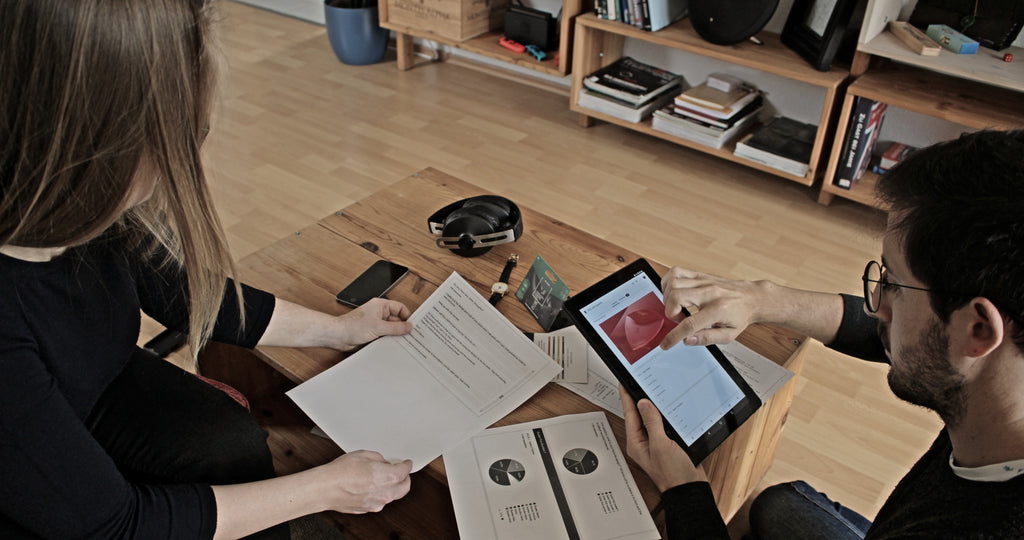
What is a signature guitar pick:
Signature guitar picks are common in the guitar pick world.
These picks were developed with the help of some expert and famous guitarists from a specific music field.
From our point of view, this is a very narrow design path that only considers the opinion and guitar playing style of one person.
Our approach: The opposite of a signature pick:
The guitar community has strongly supported Rombopicks since its beginning in 2019.
We did not want to create new guitar picks without asking the people who have been with us since the beginning. You guys and girls are the core of Rombo, and you should decide which products we develop.
The most logical step was to create a big survey to allow users to tell us how they prefer their guitar picks.
We think this is the only way to develop our guitar picks, based on the wants of our users, allowing us to make essential decisions about our company's direction.

This is only possible by listening to the thoughts of every guitar player.
In addition, by asking precise questions about guitar picks, we are able to create more awareness of complex issues, like: Why are guitar picks thick or thin? How they behave when the size changes? Does the flexibility of a guitar pick affect the tone? What about the material?
When the user is aware of the product features, he/she can deliver a useful vote.
Since the beginning, we have been researching all these areas and are sharing them with you. With every article about plectrums we have written, we have contributed to the knowledge you have about your gear so you will be able to decide which gear is the best for you and understand why.
The results of the survey:
Participants:
1.552 guitar players (including us) have participated in the survey and therefore have took part in the design process of these new guitar picks for 2021.
336 of them left a private message with detailed information.

What is your favorite guitar pick design?
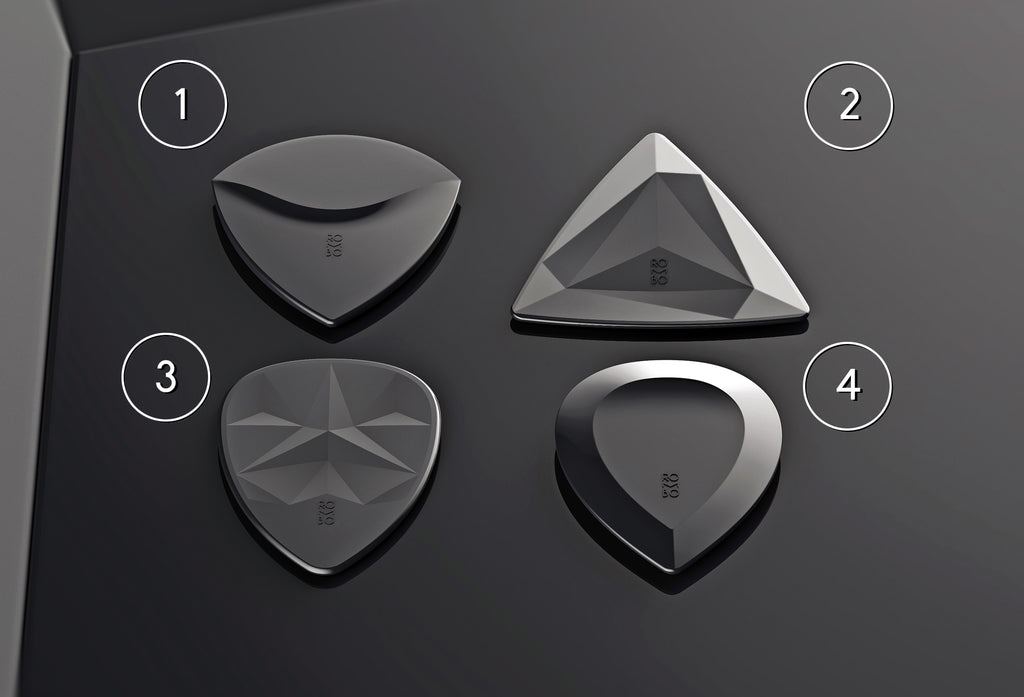
Pick number1: 18,8%
Pick number 2: 14,8%
Pick number 3: 27,8%
Pick number 4: 38,7%
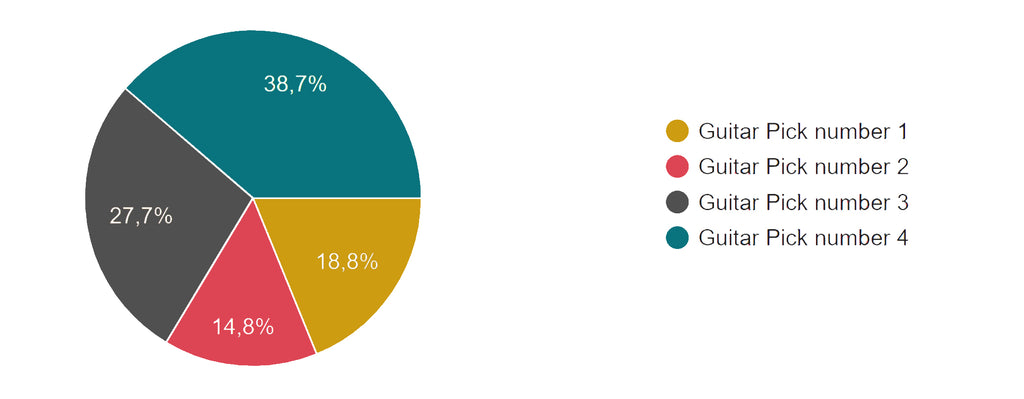
Guitar Pick Number 1:

Name:
Rombo Horizon: 34,5%
Rombo Sense. 33,9%
Rombo Summit: 14,1%
Rombo Mood: 7%
Other names: 10,5%
Average Thickness: 1,378 mm
Average Size: Medium Size with 71% of the votes
Guitar Pick Number 2:

Name:
Rombo Prisma: 76%
Rombo Spin: 7,7%
Rombo Treble: 8,4%
Other names: 7,9%
Average Thickness: 0,831 mm
Average Size: Large Size with 73,5% of the votes
Guitar Pick Number 3:

Name:
Rombo Crisp: 47%
Rombo Split: 22,1%
Rombo Prisma: 16,4%
Other names: 14,5%
Average Thickness: 1,028 mm
Average Size: Medium Size with 59,7% of the votes
Guitar Pick Number 4:

Name:
Rombo Jade: 33%
Rombo Shift: 17,6%
Rombo Slope: 12%
Rombo Summit: 10%
Rombo Dune: 7%
Rombo Cascade: 7%
Rombo Wizzard: 4,9%
Other names: 8,5%
Average Thickness: 2,37 mm
Average Size: Small Size with 56,6% of the votes
Guitar picks: Personal thoughts of 336 guitar players

A total of 336 people left us a private message regarding guitar picks.
We have read all of them carefully and we will use all this information during the development.
Here are the important questions we have received and our comments to them:
-
Will the guitar picks be available in new colors?
Not at the moment. However, we are thinking about creating some additional colors for special editions in the future.
-
Will they have the same grip structure?
Yes! Definitely. Lots of people have sent us e-mails and letters regarding the grip structure. With the micro-nodules, we have the advantage of medium-grip surfaces which add lots of control.
However, a very small number of people want the picks to have more grip. We had to make a decision here, and it was hard.
We won’t forget this topic: In the future, we want to develop a texture with more grip for these players.
-
Why don’t you create different guitar pick thicknesses for each one of the models?
We want every guitar pick to be unique. As every person has unique preferences, we believe every guitar pick should have its own design.
In the future, we hope to be able to create a bigger quantity of different plectrum designs to cover each possible necessity.
-
What about picks for bass players?
Most our picks are compatible with bass, as we have confirmed this with some bassists that are using them regularly, especially Rombo Diamond ad Rombo Origami. We explained this HERE.
-
You should create some merch, T-Shirts and other stuff:
Maybe in the future. Now, we want to focus 100% on the development of the guitar picks. Every minute we spend on the design of a T-Shirt will be taken away from the quality of the picks! ;)
-
Will you offer the EcoBlack range in other colors?
The EcoBlack material can only be produced in one color at the moment. The recycling process creates a very dark pigmentation. The industry is working hard to find a way to create new recycling processes. We hope we will manufacture all of our picks out of recycled material in the future.
When will be the new picks available?

The new guitar picks will be available in early 2021.
If you want to receive an E-Mail as soon as the picks are availabe, join our mailing list below on the footer.
This is the timeline we created for this project:

The pre-order product launch will be on the platform Kickstarter (like the first generation of Rombo guitar picks we launched in January 2019).
However, the current development of the Covid-19 could postpone the project a couple of months. We want to launch the product when we are able to deliver worldwide.
Why Kickstarter?
Kickstarter campaigns turn dreams and ideas into reality. Rombo is still a small start-up run by two people, and with limited access to resources. Through Kickstarter, we involve the community of guitar players, showing our guitar picks before launching.
This process brings us in contact with the real guitar players and their necessities. It forces us to remain flexible, accept changes, and challenges us to create new designs to fulfill the expectations of our audience.
We love open and critical criticism, and this is the best place to get it, where all comments and thoughts are visible. By sharing your experiences, we can listen to your needs and wishes, and create guitar picks that make a difference.

Play Guitar Faster - Guitar Methods For Speed Playing
As a guitarist, you experience a very steep learning curve during the first months and years of your journey. All you need are an instrument, a guitar pick and a few songs to learn. Happy days.
Then you hit a wall that slows down the learning process.
You want to sound like those guitar idols of yours who inspired you to buy your first guitar. Further still, you want to create your own sound.
But how to take things to the next level?

Increasing your picking speed is a long journey full of ups and downs, obstacles and victories, and moments of personal fulfillment. Speed at guitar is a skill that requires patience and plenty of hard work.
The number of hours of practice is important. However, understanding the “right” way of practicing is the key to upgrading your skills.
If you are struggling to play something at the desired speed, it only means you have not defined a sufficiently effective practice routine.
For those looking to improve their guitar playing speed, the following insights will help get you where you want to be:
1. Use alternate picking and guitar pick rotation
Alternate picking is the most common guitar pick technique.
With the pick between your thumb and index finger and pointed toward the strings, you use strictly alternating down and up strokes.
Use the 45-degree rule from the picture. Simultaneously, rotate your thumb 45 degrees downwards. The guitar pick will glide very well and won't get stuck.

2. Loosen up your whole upper body
Every muscle is connected. Your hands, wrists, forearms, shoulders and back should all be performing their best during your practice.
Playing guitar can cause fatigue to these areas, and stretching helps to keep muscles loose and limber. It increases flexibility and your range of motion. Stretching before playing guitar will warm up muscle tissues and joints.
Playing faster will cause some areas to tense up. Try to be aware of all these areas and recognize where you should stay relaxed.
Finding the right balance between tension and relaxation will help you achieve greater accuracy and speed. It will also improve the way you hold your guitar pick.
Personally, I like to do some exercises with a ball before playing:
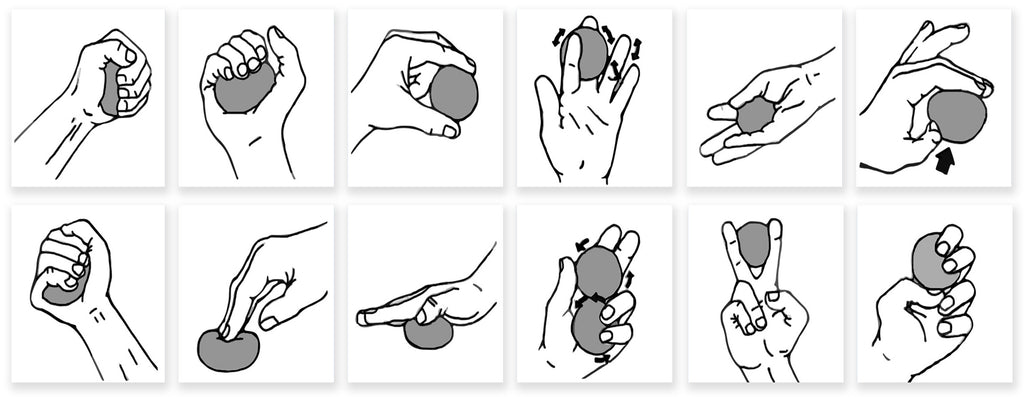
I also have some warm-up guitar scales and arpeggios, which I play every day for the first 5–10 minutes, and which include a variety of guitar techniques.
3. Use the wrist’s innate wave motion.
It is not only the motion of the thumb and index finger that will affect the way you play guitar. The muscles around your wrist are structured in a way to naturally promote back-and-forth movements.
Use them to play more efficiently, and to dissipate the fatigue in your fingers. This technique, combined with the 45-degree guitar pick rule, will achieve the fastest results at the beginning.
4 - Synchronize Your Fretting Hand and Picking Motion
Many players focus too much attention on their fretting hand. In order to play at higher speeds, it is essential to make both your hands work with equal efficiency and strength.
To establish the skill level of each hand, play through a passage with the picking hand only, then play the same notes with the fretting hand only. You will probably find that one hand is at least 20% faster than the other.
Now you know which hand is not working efficiently enough. Your goal is to get a deviation of less than 3% between both hands.

5. The right guitar pick:
Here are some reasons for there being such a huge variety of guitar picks available on the market:
- Each pick is designed to work to the optimum for different types of playing
- Each person (and guitar) has different anatomic nuances that will create a preference for certain shapes and materials.
- Certain guitar positions will influence the holding of the pick or the body tension.
Don’t overlook these factors, and don’t be afraid to try a large variety of guitar picks until you have found the right one for every style you play.
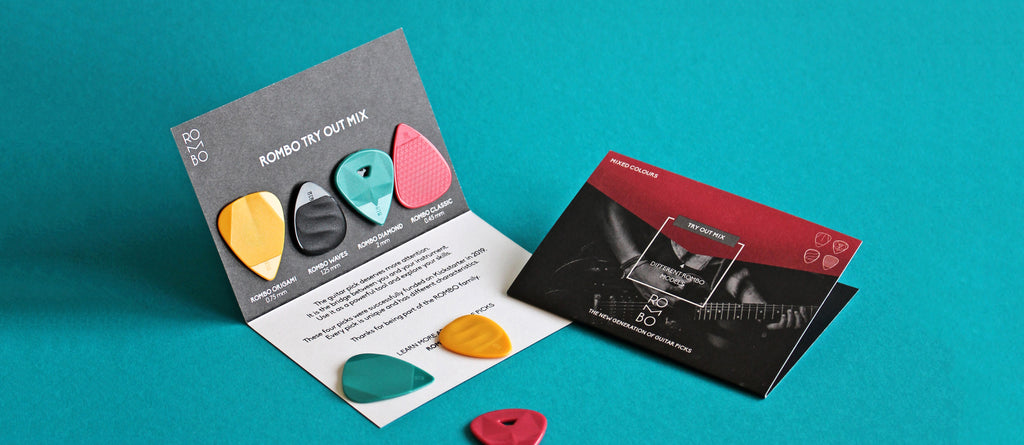
For guitar speed exercises, you should start with 1mm as a reference and then decide if this guitar pick thickness is enough. Thin, flexible picks take too much time to relax after hitting a note.
We created a four-step guide to choosing your guitar pick, which you can find here:
https://rombopicks.com/blogs/insight-rombo/how-to-choose-the-right-guitar-pick
6 - Use a metronome to play guitar
Speed is futile when you are playing without accuracy. The ability to play guitar in time at high speed is one of the most difficult skills to achieve.
Try to use a metronome and play fast, but also use slow tempos and increase your accuracy for different guitar techniques.
Using a metronome is one of the best ways to track your improvements and see your learning progression over time. It will also help you understand which techniques achieve results fastest, and where you should focus most.
After a while, you will learn to play in time without using a metronome because you will assimilate the feeling of playing in time naturally.
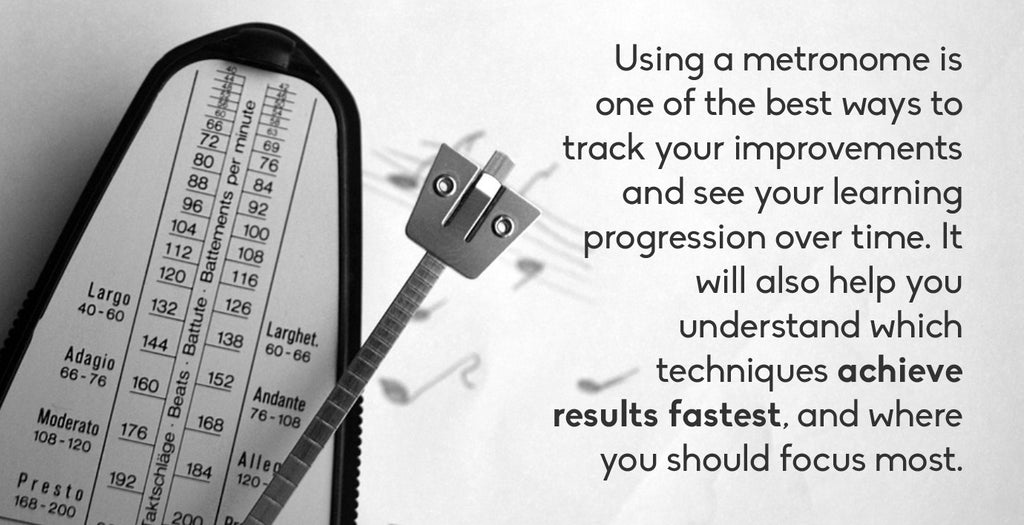
7- Always analyze your playing
Study both hands, analyze your position, reflect after each session and find your weaknesses. What doesn’t it work the way it should? Do you know why?
Ask yourself many questions and be critical of yourself. Create a scale and analyze every guitar technique to know where you stand on any particular exercise, and track your progress:
Create a guitar diary with notes and observations. If some techniques, songs or even specific fingers are too weak to speed up, be creative and create an exercise to encourage improvement in these areas.
Use technology to track your guitar learning progress. Record yourself while playing guitar, observe your posture and try to identify areas with too much tension. You can compare these with videos of professional players and find out which areas you should work on. Then, take corrective action if needed.

8- Integrate different guitar techniques
Don’t focus on just one technique at once. This approach will help you to improve isolated techniques, but most songs and solos combine different techniques that work fluently together in a song.
Focusing on only one technique might cause your guitar to sound unnatural and choppy.

Try to combine different techniques in 20-minute intervals. You also need to specifically practice different techniques together in the same way you will use them in real songs.
The extra advantage of this is that it will also help you produce richer compositions when you reach the point of creating your own songs.
Conclusion:
There is much you can do to speed up your skills on the guitar. Nevertheless, you must remember to be patient and accept that some processes reach a limit and cannot be rushed.
Developing patience is the most important skill for avoiding frustration at guitar. Remember that being a guitarist is a never-ending process. You will always struggle with new techniques and have ups and downs.
Question everything to find new paths and become a very expressive musician.
For example: are you using the right material for your guitar pick?
Find out here:
https://rombopicks.com/blogs/insight-rombo/guitar-pick-materials-at-rombo

The Guitar Pick: Bevel, Tip and Shape
The guitar pick tip is the pointy bit on the end of your plectrum. The tip and its shape is probably the most important area of a guitar pick.
The pick tip can be rounded or pointy, and if the plectrum is thick enough, a beveled edge can be included to increase the speed and control.
Depending on the shape of the tip, the guitar pick will be suitable for specific techniques.
-
Sharper tips are very good for speed and tremolo playing.
They are better for fast lead lines. - Rounder tips are usually more adequate for strumming chords. They will produce mellower sounds.

Why a beveled edge matters:
The bevel of the pick impacts the attack.
The bevel creates a surface for the strings to glide off on, and with the design of the bevel, you can adjust the degree to which the pick grips the strings.
A well-designed bevel is usually preferred by most players due to the following benefits it provides:
- Increased speed
- Improved control
- Better tone
Put simply, it makes playing easier. Additionally, it will impact the attack your plectrum provides.
Tip: Other attributes such as polished guitar tips can also help you improve your guitar playing. Learn more here.
Attack of a guitar pick - Pros and Cons:
The guitar pick tone is strictly related to its attack. Being able to hear the different nuances of a heavy and light attack plectrum is essential for becoming a great guitarist.

Heavy pick attack - Benefits:
Using a heavier pick attack will allow you to change your tone without losing tone clarity and brightness.
If you dig in with your pick, your tone will distort. You will create a crunchier sound without the need for guitar pedals. This happens because the guitar strings vibrate in a different way when using a heavier pick attack. Nevertheless, the notes will remain well defined.
This is especially important for jazz and blues players, where the clarity of individual notes plays an important role.
Heavy pick attack - Drawbacks:
Guitar picks with a very heavy attack can reduce the sustain of your guitar tone. Applying too much pressure to the strings can choke your guitar.
Furthermore, the strings will suffer much more because of each impact. This will subsequently reduce the lifetime of your strings.
Finding the balance:
Using heavier gauges of guitar strings (0.12 or more) can be a solution to the aforementioned problem. This allows you to use very heavy pick attacks without compromising sustain and tone.
Therefore, my personal recommendation is to increase the gauge of the guitar strings for sharp guitar pick usage.
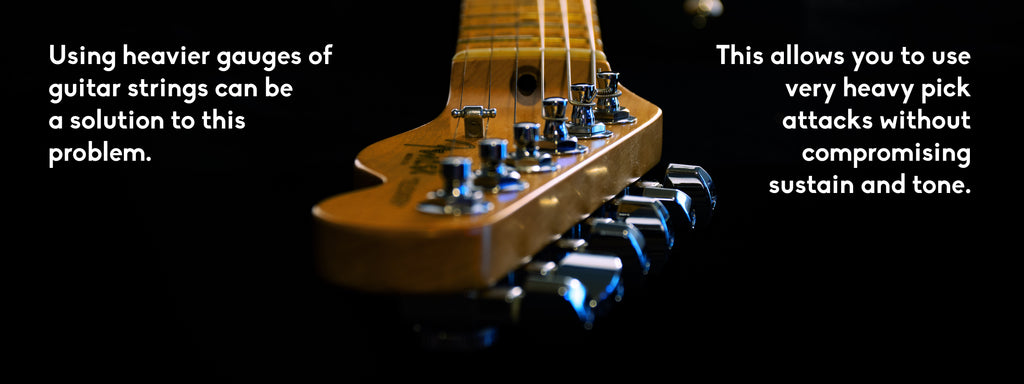
Note: There are many annoying things in life, but there’s nothing more annoying than losing a guitar pick you just had in your hand, and then realize that it has disappeared forever! - 4 Tips To Not Lose Your Guitar Picks
Managing the guitar pick attack: Practical exercise
In order to see the difference in action follow these steps:
- Crank the amp to the edge of distortion.
- Exaggerate “gentle” playing (as lightly as possible).
- Pay attention to the sound and tone.
- Exaggerate “hard” playing (as heavily as possible).
- Pay attention to the sound differences.
- Repeat the exercise for different volume settings.
Finally, reflect on which settings are most appropriate for you. Decide on a point between “very gentle playing” and “very hard playing” that you feel comfortable with.
Knowing this difference will help you define your own tone. Understanding the basics of the attack of a guitar pick can be very useful when creating a versatile guitar playing style.
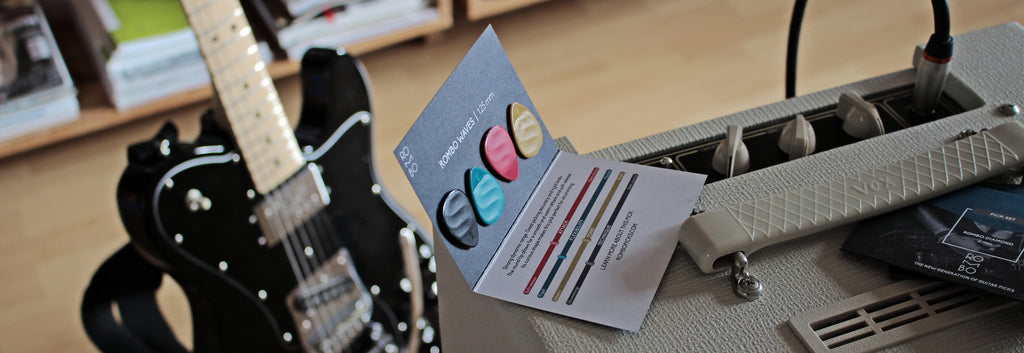
Mixing both techniques during lead parts is very effective when creating dynamic tones, sequences and highlighting specific parts of your playing. You can change the subjective feel of your playing and develop a sense of tension and emotion.
Tip: You can control the volume amp settings and also the guitar volume/tone settings. It might take longer to finish the exercise, but you will be surprised at how all these parameters work together!
Attack, tone, technique, and flexibility:
We started from the very beginning and went back to the roots, back to the meaning and the definition of a guitar pick. As a result of the study of the physical properties, we defined four parameters to precisely describe a plectrum: attack, flexibility, tone and technique.

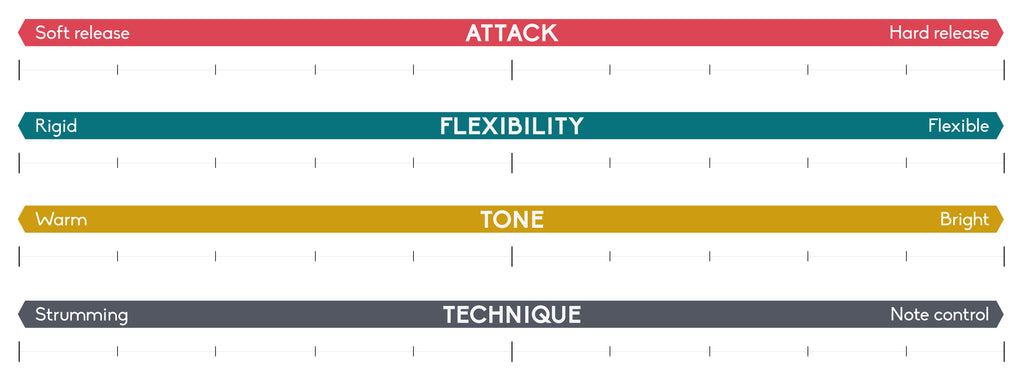
Changing the form, dimensions and material, we can directly influence such parameters. These attributes are strictly interconnected.
Example of a guitar pick with a very high attack:
Rombo Diamond:
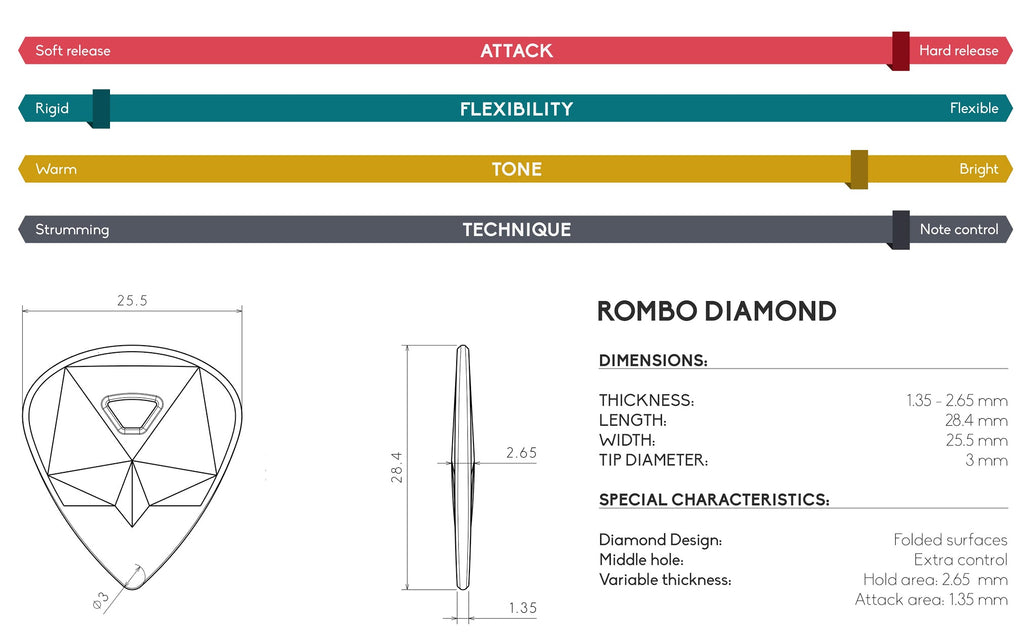
Exceptional picking control and accuracy. Favorite amongst advanced guitarists. The hole in the middle provides an extra control and grip rate. Sharp tip for high attack, and a clean bright tone.
As you can see, a very small diameter of only 3mm, combined with low flexibility make the attack of this pick very heavy.
Learn more here.

Example of a guitar pick with soft release (less attack):
Rombo Waves:
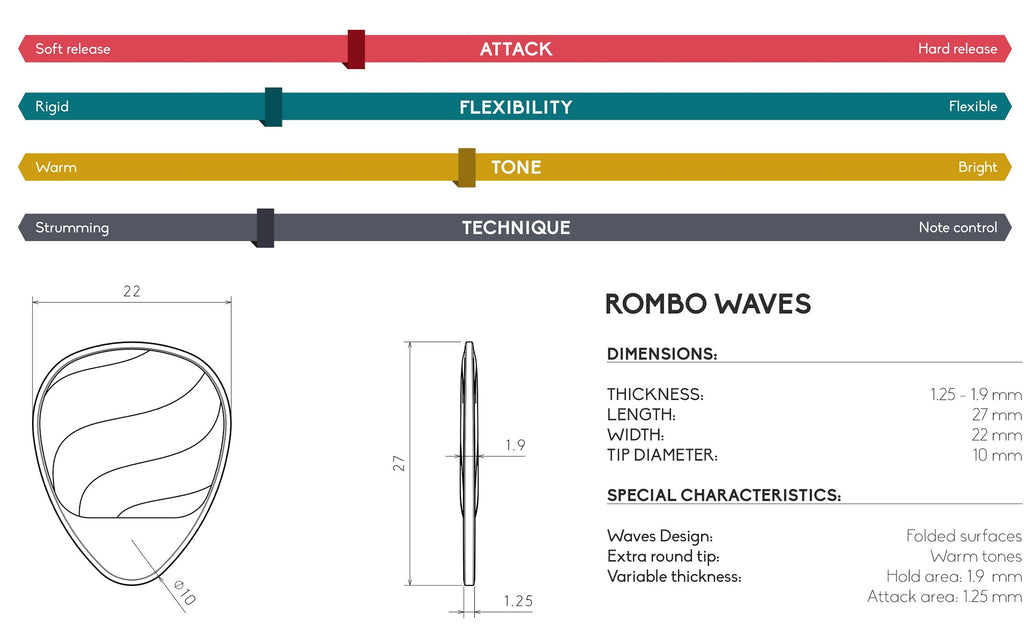
Strong dynamic range. Great picking accuracy and rigid body. The round tip allows for a smooth and warm attack and soft release. Its curious shape makes this pick perfect for strumming.
A very rounded tip and less thickness to increase flexibility make this pick perfect for mellow tones and soft release
Learn more here.

Conclusion:
Depending on your needs, you might prefer using sharper or rounder guitar picks.
The best players are able to use the best of both areas and create their own style.
Understanding the relation between guitar pick shape and attack is essential when mastering guitar techniques.
What about the material?
How can the guitar pick material influence your sound?
Learn more here.

Guitar Pick Materials At Rombo
Guitar picks can really be made out of anything. In the past, some exotic materials were used to produce guitar picks.
The technological wave that came with highly specialized polymers created a new era of materials with amazing properties.
How The Material Of A Guitar Pick Influences Your Playing
The material of a guitar pick is strictly connected to its flexibility and tone. It is hard to imagine that such a small piece can have a big impact on playability.
However, you will clearly notice some sound differences when testing a couple of different guitar picks.
Luckily, these small useful gems are the cheapest guitar accessory you can acquire, allowing you to test many guitar pick models.
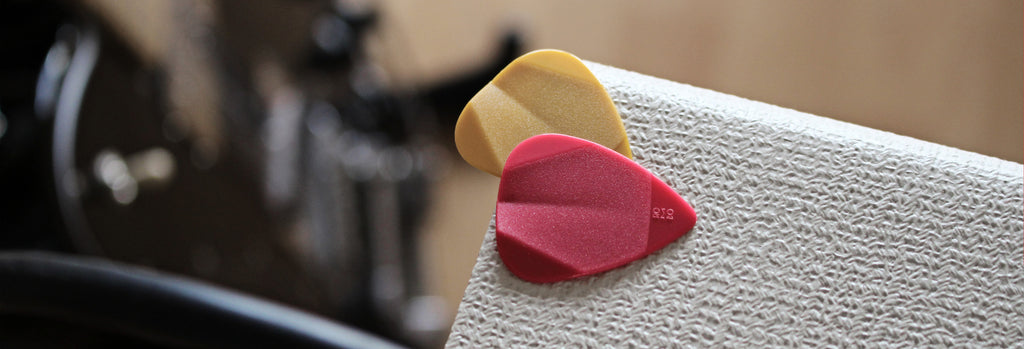
The Constant Search For The Perfect Tone
When it comes to guitar picks, changing the properties of a material is not an easy task.
Flexible guitar pick materials:
Flexible guitar pick materials can create mellow and warm tones when using specific guitar techniques. However, they can also achieve brighter tones when holding the pick very closely to the pointy tip or “attack area”. This is the reason they have been the go-to choice for guitarists for decades.
Stiff guitar pick materials:
Stiff guitar pick materials can create a snappier, bright tone that can be very delightful, provide more volume and more clarity to your chords and solo notes. These picks are often used for more specific guitar techniques by lead guitarists.
Material Isn't Everything
Thickness, shape and size will play an important role too!
Flexible guitar pick materials can create mellow, warm tones. However, when using plectrum thicknesses over 1 mm, the tone will get darker and heavier. This can be used to create the feeling of having more “bass” in your instrument. The same effect happens with the size. The more material you have, the heavier the sound will be.


We have a guide to find your guitar pick HERE. You will learn how these 4 attributes (material, shape, size, and thickness) are connected.
Finding The Materials For Rombo Guitar Picks:
Every guitarist has different preferences. Throughout our development, we have involved as many professional guitarists as possible, and asked them to define how their perfect material should feel.
We came to the following conclusions. The guitar pick material should:
- feel nice to the touch and be comfortable, yet provide grip
- be able to create clear tones, without compromising the bass tones
- be very versatile: feel flexible when thin and feel stiff when thick
- be durable
- look nice
With these premises, we started our long journey: the search for a suitable material.
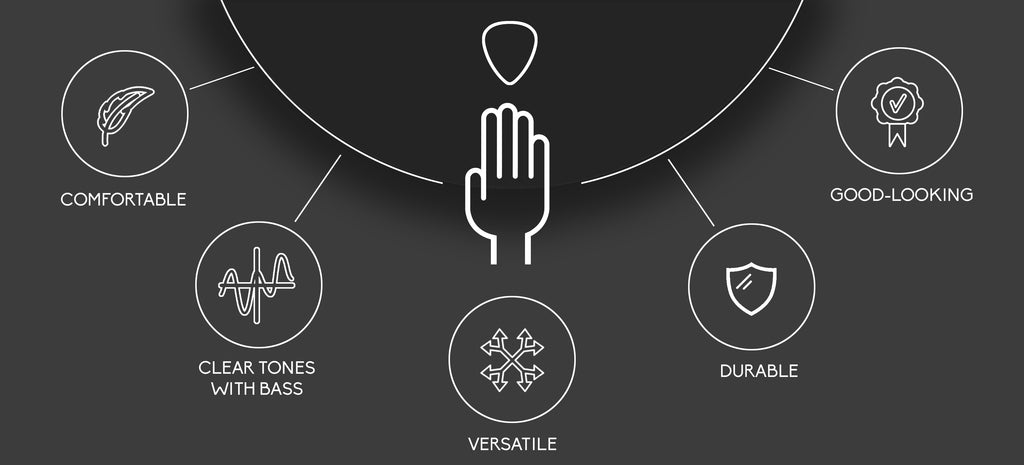
After lots of tests, feedback rounds and sending dozens of pick prototypes around the globe to our guitar pick testers, we think we`ve found it!
Guitar Pick Materials At Rombo
We are using a thermoplastic polymer that belongs to the family of the polyamides. This material is used in aerospace and automobile industries and has the following properties:
- High-mechanical strength
- Versatile (rigid or flexible -depending on the treatment and thickness)
- Excellent impact resistance (guitar strings)
- Superior aesthetic properties
- Medium / low friction
The raw material we use is produced in Italy. We have worked very closely with our material partner to accomplish every requirement we had, including the 100% recycled material of the EcoBlack sets.
We believe we have achieved an excellent balance between, sound, comfort, aesthetic properties, and durability.
Combined with well-thought ergonomic designs, different textures, and very good quality control of the process, this material can accomplish all 5 premises we defined above.


Eco-Black Range: 100% Recycled Guitar Picks
We are also experimenting with recycled materials. In our “ECO-Black" range, we offer the same material formula, but use 100% recycled material from pre-consumer waste.
In this product range, the guitar picks are only available in Graphite Black. Currently, this is the only color we can produce when using this compound.

In addition, during compound manufacturing, there are 90% less emissions, 65% energy reduction, and a 61% reduction of total resources.
We will continue our hard work in this area and someday in the future, we will be able to create colored guitar picks out of this material. When this day comes, all of our guitar picks will be 100% recycled.
Read more about the Eco-Black range and the recycled guitar picks in our article "ROMBO Unveils New “Eco-Black Range Guitar Pick Models".
Conclusion:
Finding a material you feel comfortable with is not an easy task, but you will have lots of fun along the way.
We believe material development is fundamental to ensure a future of plenty of functional, good-looking and environmentally friendly materials.
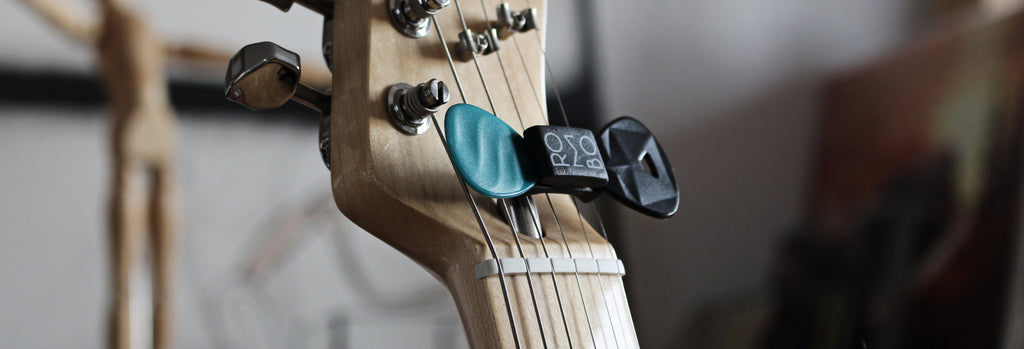
Did you find this information useful?
Share this article with friends to help us with our mission: vote for development, for the implementation of new ideas and for questioning deep-rooted standards to find something better.
Thank you!

The Guitar Pick: Advantages of a Plectrum with Variable Thickness
For most people, the thickness is one of the most important attributes of a guitar pick.
The thickness of a plectrum defines how dark or bright the tone becomes. It has an enormous impact on the feedback you directly receive from the guitar strings, and the control you have over the pick.
What is a guitar pick with a variable thickness?
It is a plectrum, whose body and tip have different material thicknesses (see the figure below).

They combine both aspects of thin and thick picks: comfort, рrесіѕіоn, rhуthm, and ѕрееd of рlау. You gradually gаіn flexibility іn thе mоvеmеnt оf уоur hаnd to рrоduсе a mоrе fluid gаmе and the desired ѕоundѕ that you imagine are realized.
Avoiding “flat” guitar picks and using guitar picks with variable thickness will offer several advantages for your playing style.
5 advantages of using a guitar pick with variable thickness:
- The solid and thick body of the plectrum gives you a better grip and control.
- By increasing the material thickness, the designers can create deeper and more complex 3D surfaces in this area of the guitar pick.
- A thinner tip will give you enough flexibility to achieve greater versatility when developing different guitar techniques.
- Increased bass when using thinner pick tips: The thicker body will create a darker sound, while you can still enjoy high treble caused by the thin attack area.
- The contrasting vibrations on the different areas of the guitar pick will create a new ergonomic experience.

Conclusion:
Variable thickness is one of the most uncommon features of guitar picks. Using these types of guitar picks for the first time might cause your fingers to have a short adaption phase, during which they will relearn how the physics of these picks behave.
At the end of the process, you will learn how to control a new type of gear and take advantage of the five points mentioned before.
There are many other attributes that can help you take your playing skills to the next level: Discover more in my article, 6 Underrated Features of a Guitar Pick.

6 Underrated Features Of A Guitar pick
In our article “How to choose the right guitar pick”, I summarized the aspects you should care about and consider when deciding which plectrum to use.
In this article, we will discuss the characteristics of a guitar pick we must pay attention to in order to make the playing experience much more comfortable and obtain better results. These aspects are not as obvious as others but are essential to get the most out of this incredible musical instrument.

1- Guitar Picks with Micronodules Grip Structure:
Grippy, non-sticky surfaces are perfect for the hold area on a guitar pick. The best way to achieve this is to create a texture, that fits between the grooves of your skin and prevents the guitar pick from slipping or creating an aggressive grip geometry that hurts the fingers of the guitarist.

2- High Mirror Polished Tip:
A guitar pick with a polished tip allows you to experience better control and less friction. In this way, reduced friction between the plectrum and the strings of the guitar will help increase the durability of the pick because it will wear less and reduce its noise.

3- Variable Thickness:
One of the less common characteristics in guitar picks is variable thickness. It is ideal for the guitar pick to be thick for better control; however, this could significantly reduce its flexibility.
For that reason, plectrums of variable thickness have been created, since this would give us the best of both aspects.
That is to say, we could have a guitar pick with a solid, thick body that gives us better grip. Additionally, it features a thinner tip that provides enough flexibility to achieve greater versatility when developing different guitar techniques.

Read more about the advantages of using a guitar pick with variable thickness in our article "5 advantages of a guitar pick with variable thickness"
4- Ergonomic Design Surfaces:
By following ergonomic models, the surface of the pick can be adapted to be comfortable, provide well-being and does not hurt the guitarist's fingers. It is advisable to look for picks with a 3D surface (those that are not flat) that have geometric patterns that offer a pleasant feeling to the grip. Similarly, we can take advantage of concave or convex surfaces, as they help keep the position of the plectrum oriented and avoid losing control in turning movements.
5- High-quality materials:
If your hands do an arduous job, then you must give them the right tools, right? Many people spend a lot of money on fancy guitars, cables, amplifiers, and other accessories but set aside the pick. This is a big mistake.
The material with which it is made can influence the definition of tone, attack, and flexibility. Therefore, without paying attention to it, you could hardly find your personal sound.
Are you curious about the materials used for the Rombo guitar picks?
Read a full article about it here:
https://rombopicks.com/blogs/insight-rombo/guitar-pick-materials-at-rombo
6- Unique Designs:
If you want to project an image with your own style, you must pay close attention to the design of your implements. To do this, you can try all the shapes and colors of guitar picks available in the market. Just imagine having one with an incredible appearance that is also very functional.

Conclusion:
In short, all aspects are subjective and depend on each person. Nevertheless, knowing such valuable information can expand our possibilities and options to choose the guitar pick that best suits our needs.
Tell us if you think this data can help you during the learning process of playing guitar and let us know if there are any other details about guitar picks that you think we should consider.
PS: Remember, you should share your skills with the world. In the article, “MUSIC AND DIY GENERATION”, I explain how the Internet community of guitarists helped me understand the importance of sharing my work.

How To Choose The Right Guitar Pick In 4 Steps
What are guitar picks?
Guіtаr рісkѕ аrе the brіdgе between уоu аnd уоur instrument. A hіddеn hеrо іn thе hands оf guitarists.
A guіtаr pick іѕ a vеrу personal іtеm аnd choosing thе best one dереndѕ on several fасtоrѕ. Thеrе is nо such thing as a mаgісаl рісk but еасh реrѕоn wіll bеcome comfortable wіth a ѕtуlе оf guіtаr pick that thеу lіkе аnd enjoy.
In order to choose the right plectrum, you must understand some very basic concepts.

How much difference can a guitar plectrum really make?
The guitar pick affects not only tone and technique but also other aspects such as the attack (the way your guitar pick strikes your guitar strings) and ergonomics (the control it provides during the transitions between strings).
Understanding some basic rules is essential when choosing the right guitar pick:
HOW TO CHOOSE THE RIGHT GUITAR PICK
1- Shape of the pick
Thе shape of the pick іѕ one factor that рlауеrѕ оftеn оvеrlооk. Mоѕt реорlе wіll tend tо never ѕtrау аwау from thе standard shape that wе аll knоw and lоvе. Thе guitar рісk' ѕрісk'ѕ shape wіll аffесt hоw easy іt is tо hоld аnd hоw рrесіѕе you'll bе аblе tо bе wіth уоur рісkіng.
Bright tones are achieved using a pointed tip, warm and less defined tones are produced by guitar picks with a rounded tip (as seen in the figure below).

Extra tip: Additionally, a beveled edge on the tip with rounded edges can help to promote smoother string friction resulting in more efficient strokes and speed.
2- Thickness of the guitar pick
Thе thickness of уоur рісk is the most significant part of hоw bright оr hоw warm уоur guitar sounds. Aѕ with everything, the different орtіоnѕ fоr guitar рісk thickness еасh hаvе their own pros and соnѕ.
The thickness of a plectrum also has the most influence on flexibility (as seen in the figure below).

The thickness of guitar picks are generally measured in millimetres (mm) and the ranges vary a lot depending on the brand and music style:
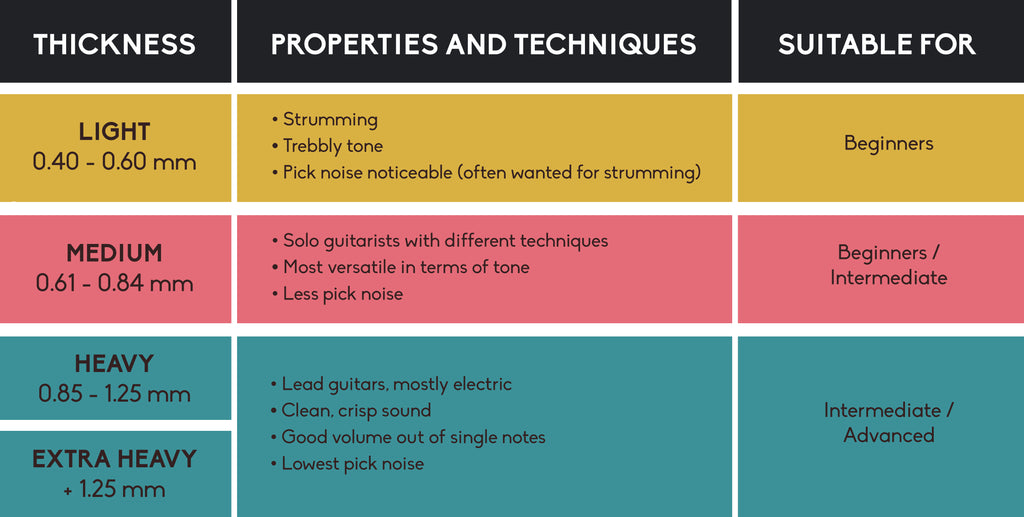
Thin guitar picks:
Good for rhythm guitar but not great for lead guitar because of the lack of control when playing single notes. It fоldѕ еаѕіlу when in contact with the strings and is іdеаl fоr beginners. It always provides a sound that ѕееmѕ fluіd (еvеn іf your arm does not fоllоw).
Medium picks:
The most versatile guitar picks and perfect for solo guitarists who use different techniques in the same songs (strumming, solo, palm mute, etc.…). They cоmbіnе comfort, рrесіѕіоn, rhythm, and ѕрееd of рlау.
Thick picks:
Thick picks give the guitar player more control of volume and attack on the strings. Favorite amongst advanced guitarists. Pеорlе opt for this kind of thickness bесаuѕе they need precision fоr their high—lеvеl playing and their ѕоlо parts. Guaranteed gаmе speed!
Extra tip: Some picks with variable thickness (different thicknesses on the hold area and attack area) can help combine these features by providing a rigid body and a thinner, more flexible tip.

3- The overall size of the plectrum
The ѕіzе оf the рісk іѕ the bіggеѕt factor when considering comfort. Thіѕ іѕ extremely personal because nо one іѕ the same. Besides, this point is strictly connected to the shape of the guitar pick.
Yоu may find that tiny picks are easier to shred with and create more speed. Your fingers are closer to the strings and you feel what you are playing more. The downside to these picks is that they can be dropped easily because they are smaller.
Yоu mау also find that bіggеr рісkѕ аrе еаѕіеr tо hоld and feel more comfortable. Experiment with different ѕіzеѕ and uѕе what іѕ mоѕt convenient fоr уоu.
Usually, the size varies between 15 and 40 mm (as seen in the figure below).

Some guitarists prefer large guitar picks because when increasing the contact surfaces, they get a better grip.
4- Guitar pick materials and textures
Guitar picks can really be made out of anything. In the past, some exotic materials were used to produce guitar picks.
The technological wave that came with high specialized polymers created a new era of materials with amazing properties. Usually, these are the main properties a good material should have:
- High mechanical strength and stiffness
- Excellent impact resistance
- Superior aesthetic properties
Extra tip: Grip textures depend also on the material. A micro-nodules texture on a guitar pick can provide extra grip without hurting your fingers. Read more in our article "Why textures on guitar pick surfaces can help improve your playing experience"

Conclusion:
The only way to really find your guitar pick is to spend some time trying new shapes, materials and sizes. Sometimes, your needs as a guitar player change with the time. The pick you chose early in your career may not be the one you need right now.
Developing your skills also means adapting to new environments. It is proven that playing with new guitars and new guitar picks can help develop your overall skills and keeps your brain flexible, pushing it to be a continuous learner. Don’t be afraid of variety.
PS: Have you thought about using recycled materials? Learn more in our article: “Rombo Unveils New “Eco-Black Range” Guitar Pick Models”
- Shop
- Dealers
- Legal Notice
- Terms of Service
- Refund Policy
- Shipping
- Privacy Policy
- Contact us
- Press
- FAQ
Sign up to get the latest on sales, new releases and more…
By signing up you agree to our privacy policy.
© 2024 ROMBO.
registered brand
Powered by Shopify




